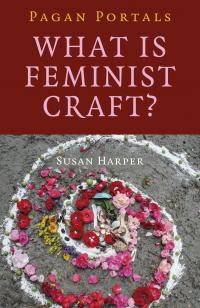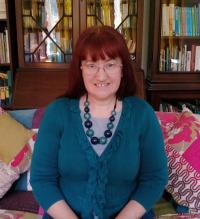
 Feminist Craft - Susan Harper
Feminist Craft - Susan Harper
Foreword
It is the afternoon of the Spring Equinox, a damp and fresh March day in 1995. I have been invited to an Ostara celebration at the home of one of the staff at my residence hall at the University of North Texas, along with another of my friends. We’re both relatively new to practicing Wicca, inspired by our readings of Starhawk and Scott Cunningham. We arrive at the cute little bungalow on a side street in our college town and, with some trepidation, knock on the front door. We are greeted by a group of women, most of them in the 30s and 40s, wearing bright tie dye, silver jewelry, and no shoes. We place our potluck contributions on the table in the tiny kitchen, then join the women in the dining room, where we are going to make masks of our faces with gauze strips covered in plaster. Nearby an array of paints, beads, rhinestones, feathers, and other fancy bits are laid out on a table covered in newspaper.
A woman I’ve never met before helps me coat my hairline with petroleum jelly, then begins gently smoothing the wet plaster strips over my face. I can’t talk, because I have to keep my face still under the layers of mask as they’re built. And so I listen. I listen to the laughter of the dozen or so women in the kitchen, in the living room setting up the altar. The sound is musical, magickal, and comforting all at the same time.
Our masks set, we leave them on the table to dry -- each of them recognizable, unique, beautiful. We head to the living room, where the window is full of plants, the furniture has been pushed back a bit, and the coffee table has been transformed into an altar. I see all the Wiccan tools -- athame and wand, chalice and bell -- along with flowers and Goddess figures that I recognize from my recent art history class as “neolithic.”
The priestess at the center creates the circle in the manner I’ve seen in Wiccan circles. We call the cardinal directions -- North, East, South, and West -- and the elements. The priestess invokes the Goddess, in her forms of Demeter, Perspehone, Kore. I take a deep breath and wait for her to invoke the God, as we do in the Wiccan circles I’ve been to.
She doesn’t. I feel my friend look at me with a question in her eyes. I raise my eyebrows and shake my head, equally confused. But as the priestess begins to speak, to tell the story of Demeter and Kore, of the Spring return, I find myself entranced. She leads us on a meditation where we see ourselves as the Kore, returning from our season in the underworld, where we have gone to heal and let go. She talks about the power of women, the power of the Goddess, the power of woman as Goddess. About finding and claiming our own power, rather than drawing power from something outside us.
And it occurs to me, that this is how it should be. That this is what I was looking for when I started reading about witchcraft. That this is where I need to be. That this is what magick feels like.
I leave that celebration, many hours later, transformed.
I was 19 years old.
And over 25 years later, I can say that my life has never been the same since that moment. That moment when I waited for the masculine form of God to be invoked, and that moment when I realized that my magick was complete without it. That moment when I looked around that living room and I saw the Goddess in the women around me, and they saw the Goddess in me.
I create this book in honor of those women, and in honor of the woman I was then and am becoming, and in honor of all the witches who have helped me grow in my magick, in my politics, and in my understanding these are not separate things.
To Be Continued...
Categories:
0 comments on this article






